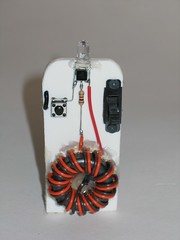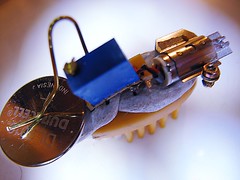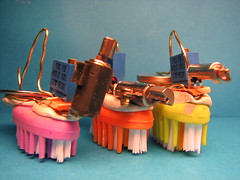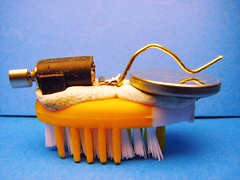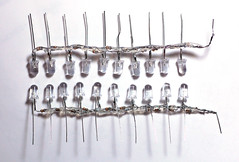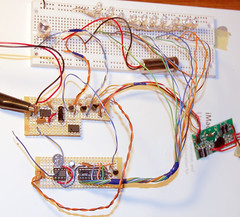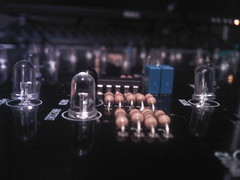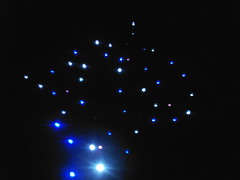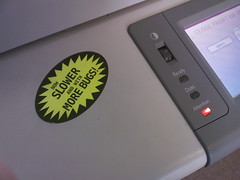Well, if you insist….
Conversation hearts: Stamp your own messages
Last year as Valentine’s day approached we suggested writing new messages on your conversation hearts and loading up your trebuchet. We still advocate catapults for Valentine candy distribution and disposal, but we’ve upgraded the presentation a bit. With a rubber stamp kit and a food-safe pen, you can stamp your messages so they look nearly authentic, but have much more appropriate messages.
Continue reading Conversation hearts: Stamp your own messages
Linkdump: February 2008
- Mickey Mouse Logic is darn useful.
- Gag gift for a cat owner
- Xylocopa Design: especially the anglerfish earrings.
- The Zero Dollar Homepage
- Mini Yip Yip
- Valentine on a Peggy.
- I love Fred products. Check out the packaging on this one.
- low-voltage fuorescent driver
- Pac Snacks
- Magnet curtains
- Cute AVR ISP to breadboard adapter PCB. [via]
- High-voltage cake
- Research LOLcats
- SpriteStitch
LOLtronics: invisible printed circuit board

Adapted from the original by John Shadle, and used by kind permission. (Thanks!)
Project: Guerilla Art
Your task this week, should you choose to accept it, is to do everything in The Guerilla Art Kit (available at Amazon, Powells, SFMoma, and your local bookstore) by Keri Smith. Maybe doing everything is a little ambitious, but we exhort you to try these projects, or at least read the book.
We recently got a copy. We had to, since it had the subtitle “for fun, non-profit, and world domination.” Being in the world domination business ourselves, it’s important to know the competition. It turns out that she’s good. Very good.
Continue reading Project: Guerilla Art
“Peggy,” A Light Emitting Pegboard Display
With all the cool things that you can do with LEDs today, there is still one thing that’s lacking: simplicity. If you want to run a bunch of LEDs at a time, you usually end up spending a fair bit of time worrying about series and parallel combinations, matching brightness, and picking load resistors. Or, if you’re a beginner, maybe you only get one third of the way through the previous sentence– wondering if you’re already in over your head.
Suppose that you want to make a big LED display for your window or wall: maybe it’s your logo, a symbol, your favorite 8-bit character, or maybe even a sign that spells out words like “OPEN” or “ON AIR.” How do you go about it? The usual DIY solution involves drilling holes in a panel to fit your LEDs, then spending a heck of a lot of time wiring everything up– ending up with one resistor per LED (and a three-dimensional mess if you happen to look at the back side of the panel). And, if you do everything in the most obvious ways, it can even end up consuming a surprising amount of power.
While I have certainly spent my share of time constructing things with the aforementioned technique, at some point it becomes clear that there has to be a better way. In this day and age, shouldn’t LEDs be about as difficult to play with as, say, a Lite Bright? Today we are releasing a new open-source hardware and software design that takes some of the sting, complexity, and mess out of playing with LEDs. It’s a versatile and powerful light-emitting pegboard that lets you efficiently drive hundreds of LEDs in whatever configuration you like, without so much as calculating a single load resistor.
Continue reading “Peggy,” A Light Emitting Pegboard Display
Learn about microcontrollers at TechShop in 2008

Starting next week and over the next few months, I’ll be teaching several different self-contained microcontroller-oriented classes at TechShop, at different levels of skill and with different emphases:
- Soldering Project: Build a Micro Readerboard
- Soldering Project: Build an AVR Programmer
- Seminar: Introduction to AVR Microcontrollers
The classes are held at TechShop, a San Francisco Bay Area “open-access public workshop,” located just off of 101 in Menlo Park, where you can go use a wide range of tools to make things, and take all kinds of classes.


Soldering Project: Build a Micro Readerboard
This is a fun little soldering class, suitable for anyone with a bit of soldering experience (even youngsters), where you can customize the phrases in and build your very own LED Micro-Readerboard. It’s a cute little thing that spells out a preprogrammed messages (e.g., your name), one letter at a time, on a single-character alphanumeric display. In the class, you get to choose what messages to put on your readerboard, solder it together and take it home. It’s a neat, self-contained project that’s a great example of what you can do with a little AVR microcontroller. This is an intermediate soldering class; a little bit of prior soldering experience is assumed. The class typically runs about 90 minutes, but soldering experts will finish more quickly and we’ve reserved space for two hours just in case. Class size is limited to 5 students.
This class is scheduled to be given
- Saturday, 2/9/08 1:00 PM
- Saturday, 2/23/08 4:00 PM
- Saturday, 3/8/08, 1:00 PM
- Saturday, 3/22/08, 4:00 PM
Sign up here.
And speaking of AVR Microcontrollers….
Seminar: Introduction to AVR Microcontrollers
 AVR microcontrollers are powerful and versatile single-chip computers that cost only a few dollars each. You may have noticed that a number of our interesting projects are based around these, using them to make smart little toys and machines.
AVR microcontrollers are powerful and versatile single-chip computers that cost only a few dollars each. You may have noticed that a number of our interesting projects are based around these, using them to make smart little toys and machines.
This class is aptly billed by TechShop as “How To Use AVR Microcontrollers in Your Projects.” Indeed. We’ll be bringing along a number of our cool AVR-based Evil Mad Scientist Laboratories projects from to show off some of the things that you can do with these little marvels, and how you might go about doing it.
Formal class description: “AVR microcontrollers are powerful, versatile and inexpensive single-chip computers that are remarkably easy to program in C, using entirely free and open-source tools that run on Macs, Windows, and Unix-like operating systems. In this practical introduction to AVR microcontrollers, we’ll take it from the beginning so that you can get started using them for your own cool projects. Some topics to be covered include: different types of AVRs and how to pick one for your application, getting a programmer, installing software tools, how to get started actually programming them, and how to download and run your code on the microcontroller. Class format is a one hour lecture followed by show-and-tell demonstrations and ample time for questions.”
This class is scheduled to be given
- Tuesday, 2/5/08 6:30-8:30 PM
- Saturday, 2/23/08 1:00-3:00 PM
- Monday, 3/3/08, 6:30-8:30 PM
- Saturday, 3/22/08, 1:00-3:00 PM
And speaking of programming….
Soldering Project: Build an AVR Programmer
 In this class you will solder together, test out and get to take home a USB programmer for AVR microcontrollers. With this hardware tool and free cross-platform software, you can use your computer to write code for and program these little one-chip wonders.
In this class you will solder together, test out and get to take home a USB programmer for AVR microcontrollers. With this hardware tool and free cross-platform software, you can use your computer to write code for and program these little one-chip wonders.
This is an Intermediate Soldering Project; you must have prior soldering experience. You are encouraged, but not required, to bring a laptop along. (If you do bring your computer, you should have a chance to install the necessary software and test it out with your new programmer.)
Class size is limited to 5 students.
This class is scheduled to be given
- Saturday, 2/9/08 4:00-6:00 PM [Full!]
- Sunday, 2/24/08 2:00-4:00 PM — Just added!
- Saturday, 3/8/08, 4:00-6:00 PM [Full!]
Sign up for these and other TechShop classes here.
New goodies at the Evil Mad Science Shop
Big, bad, beautiful and bright 10 mm diffused PINK LEDs, just the thing to help you make that ultra-geeky Valentine’s day gift! Seriously hard to find. Cheaper than diamonds.
[Product page]
(Remember: What better way to say “I love you,” than with the gift of doped semiconductors exhibiting radiative recombination properties?)
High-quality black and white vinyl stickers, 8.5″ x 1.5″, $1.00 each. [Product page]
Lots of people are apparently afraid of LEDs and wires. Show them that you aren’t.
Resistor lead forming tools, as seen in this article.
[Product page]
20-pin DIP ZIF sockets. Cheap.
Perfect for programing ATtiny2313’s or other small DIP microcontrollers.
Also recently added, for those of you that find this sort of thing exciting: surplus 22-pin sockets and 10-pin headers. (Yow!)
Tales from the Auxiliary
The Evil Mad Science Auxiliary is a public group on Flickr for anyone to add photos that are (at least marginally) related to posts and projects from Evil Mad Scientist Laboratories.
Lately some fantastic photos and projects have shown up in the group, so we thought that we should stop and round up a few– not all– of the great things that we’ve seen there.
The photos below were taken by their respective owners; click on the individual photos to get the full story.
A dark detector built by cyenobite, using a tiny battery holder.
Beautiful Joule Thief light by Jimmie Rodgers
Adam Greig has been having fun with AlphaPOV. (Results here.)
Francesco (Flickr user fdecomite) made this amazing army of BristleBots, photographed with the help of his spiffy LED ring light. He even made some excellent videos of the little guys in action.
Steve Lodefink has been busy building up this set of electronics for an extra-spiffy handlheld blaster. Based on 555 and 4017 chips, it has some elements in common with our little cylon circuit. I can’t wait to see what it looks like when it’s done!
Channon (Flickr user plik the geek) is building up one of our interactive LED kits.
He also decorated his office printer with an overly honest label. (Coincidentally, we also did this to our own office printer.)
Speaking of interactive LED kits, A Oli Wood contributed this fabulous time exposure of his completed circuit.
So… If you’ve got pictures or projects that were in some way inspired by our projects, we would as always love to see them in the Auxiliary. And to everyone who has contributed, thanks for your cool pictures!
















